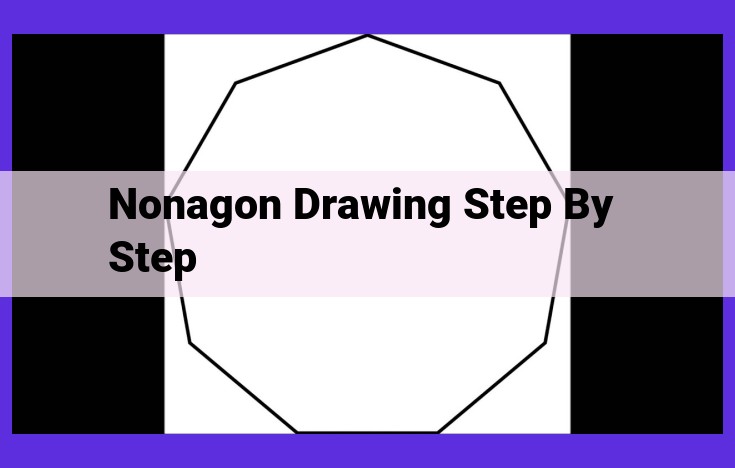Nonagon Drawing Step by Step:
A nonagon is a polygon with 9 sides. To draw a nonagon, draw a circle and locate its center. Divide the circumference into 9 equal parts to find its vertices. Connect adjacent vertices to form the nonagon. Ensure accuracy by using a compass or ruler, dividing the circle carefully, and checking symmetry. Understanding concepts like radii, angles, and faces is crucial for precise drawing.
Nonagons: Unveiling the Enigmatic Nine-Sided Shape
Embark on a geometrical journey as we delve into the captivating realm of nonagons, shapes that intrigue with their nine sides. Nonagons find diverse applications, enriching fields such as architecture, engineering, and even sacred geometry.
Etymology and Applications
The term “nonagon” originates from Greek, where “nona” signifies “nine” and “gon” means “angle.” These nine-sided wonders exhibit a unique balance and symmetry. A prominent example is the Baha’i Temple in Haifa, Israel, whose elevated dome displays a graceful nonagonal shape. Other notable examples include the nine-sided towers of medieval castles and the intricate patterns in Islamic art.
Geometry Concepts
To unravel the intricacies of nonagons, we must first familiarize ourselves with key geometry concepts. A circle, defined as a plane figure enclosed by a continuous curve equidistant from a fixed point (center), plays a pivotal role. Radii (plural for radius) are line segments connecting the center to any point on the circumference, while diameters span the circle, passing through the center.
Circumference, measured along the circle’s outer boundary, is calculated using the formula C = πd, where d represents the diameter and π is an irrational number approximately equal to 3.14. Dividing the circle into nine equal parts yields the nonagon’s vertices (corners) and sides (line segments connecting the vertices).
Understanding Geometry Concepts: Keys to Drawing a Nonagon
In the world of geometry, the nonagon stands as a symbol of precision and symmetry. Composed of nine sides and nine angles, this enigmatic shape finds applications in architecture, art, and design. To master the art of drawing a nonagon, a firm understanding of fundamental geometry concepts is paramount.
Circles, Radii, and Diameters
A circle is an essential element in drawing a nonagon. A radius is a straight line that extends from the center point to any point on the circle, while a diameter is a straight line that passes through the center point and connects two opposite points on the circle. By understanding these concepts, we can establish the foundation for constructing an accurate nonagon.
Circumference, Angles, and Sides
The circumference of a circle is the total distance around its edge. In a nonagon, each angle measures 40 degrees, and the total circumference is divided equally among the nine sides. By calculating the circumference and dividing it by 9, we can determine the length of each side.
Faces and Vertices
A face is a flat surface of a three-dimensional figure, while a vertex is a point where two or more sides meet. In a nonagon, the faces are the nine sides, and the vertices are the nine points where they intersect. Understanding these concepts helps us visualize and construct the nonagon’s shape.
Step-by-Step Guide to Drawing a Nonagon: A Journey into Geometry
Embark on a journey into the fascinating world of geometry as we guide you through the steps of drawing a nonagon, a polygon with nine equal sides and angles. Understanding the principles behind this drawing will not only enhance your artistic skills but also deepen your appreciation for the beauty and precision of mathematics.
Step 1: Defining the Center Point
Like a compass pointing true North, finding the center point is crucial for a well-balanced nonagon. Choose any point on your drawing surface and mark it as the center. This will act as the focal point for all subsequent steps.
Step 2: Drawing a Circle
With your compass set to an appropriate radius, carefully draw a circle around the center point. This circle will serve as the foundation for your nonagon. The radius determines the size of the nonagon, so choose a length that fits your desired outcome.
Step 3: Finding the Vertices
Divide the circle into nine equal parts by marking points regularly spaced around the circumference. These points will represent the vertices of the nonagon. Use a protractor or the equally divided marks on the compass to ensure accuracy.
Step 4: Connecting the Vertices
Now comes the moment to connect the dots! Starting from any vertex, draw a straight line to the next vertex, and so on, until you have joined all nine vertices. The lines should be of equal length, forming the sides of the nonagon.
Congratulations! You have successfully drawn a nonagon. Remember, practice makes perfect, so don’t be discouraged if your first attempt isn’t flawless. With time and patience, you’ll master the art of drawing this nine-sided shape.
Tips for Accuracy and Precision in Drawing Nonagons
Accuracy and precision are crucial when drawing a nonagon to ensure a geometrically sound representation. Here are some valuable tips to enhance the precision of your drawing:
Use a Compass and Ruler:
Utilize a compass to construct the circle that will form the basis of the nonagon. This tool ensures an even and symmetrical circle, reducing the risk of distortion. Similarly, use a ruler to draw straight lines connecting the vertices.
Divide the Circle Carefully:
Divide the circle into nine equal parts before finding the vertices. This can be achieved using a protractor or a ruler and compass method. Precision in this step is essential to ensure the vertices are evenly spaced and the nonagon is symmetrical.
Check the Symmetry:
As you draw the nonagon, regularly check its symmetry to ensure it is balanced and even. Fold the paper along the axes of symmetry and observe if the drawing matches on both sides. This technique helps identify any deviations from symmetry and allows for corrections.




